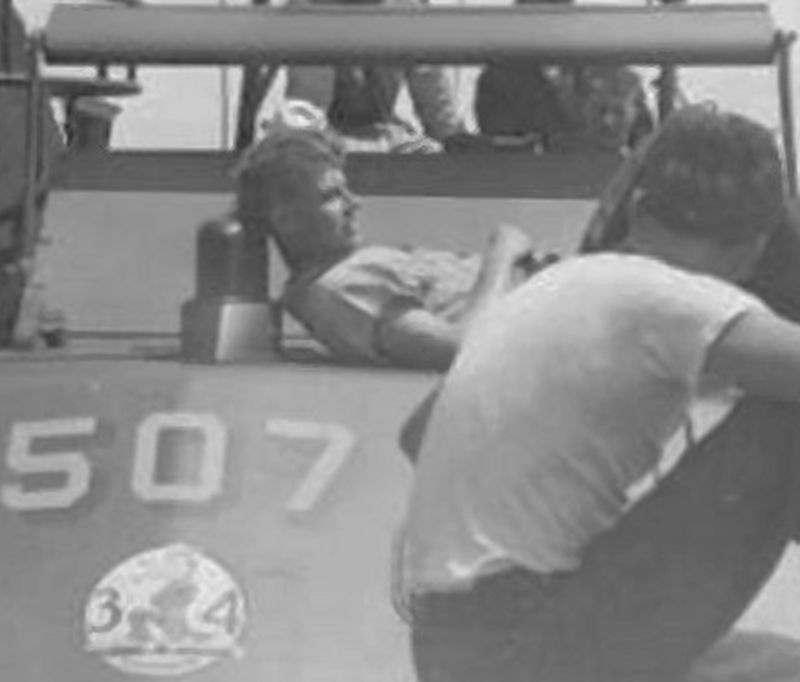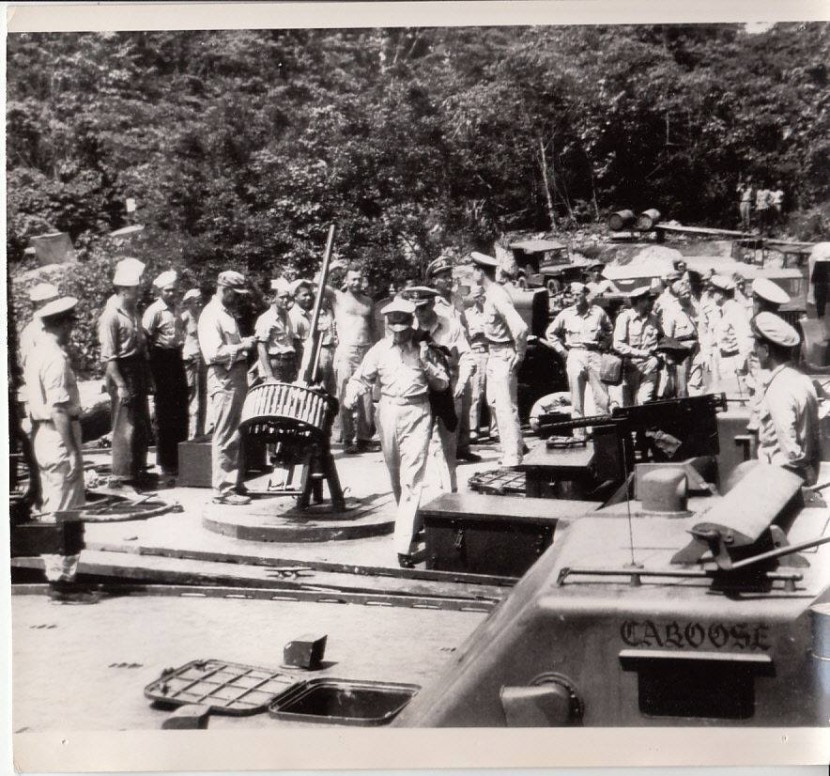| Author |
Topic: PT 515 Cherbourg |
|
Jeff D

Moderator

|
   
 

  Posted on: Feb 13, 2019 - 7:04am Posted on: Feb 13, 2019 - 7:04am
|
I think you are right, leveling the deflector in this 507 photo seems to show a straight starboard stanchion and a slightly offset port one. It looks to me that the offset was spread out more than the drawing shows, making it harder to detect:

|
Total Posts: 2202 | Joined:
Dec 21, 2006 - 1:30am | IP
Logged
|
|
Drew Cook

TOP BOSS

|
   
 
 Posted on: Feb 13, 2019 - 11:40am
Posted on: Feb 13, 2019 - 11:40am
|
Yours looks good, Arjan, but while viewing "They Were Expendable" over the years, I always wished they'd taken those darn things off the two 80' Elcos in the film.
After all, they removed the stern 20mm guns!
|
Total Posts: 1306 | Joined:
Oct 19, 2006 - 10:44am | IP
Logged
|
|
Arjan Wiskerke

MASTER
|
   
 
 Posted on: Feb 13, 2019 - 12:19pm
Posted on: Feb 13, 2019 - 12:19pm
|
Thanks Drew . I used to have a copy of that film on video (recorded from tv) but I binned it with the video recorder and the other video tapes some 10 years ago. I would definitely like to watch it again. I believe I once read on the forum which boats were used for the film but I forgot.
I don't know anything about aerodynamics, could someone explain how the wind deflector was supposed to work ?
Regards,
Arjan
|
Total Posts: 173 | Joined:
Dec 22, 2018 - 12:04pm | IP
Logged
|
|
Will Day

New Member
|
   
 Posted on: Feb 13, 2019 - 3:13pm
Posted on: Feb 13, 2019 - 3:13pm
|
I believe the Elcos were PT-139 & PT-141. The Huckins were
PTs 98,100,101 & 102.
Will |
Total Posts: | Joined:
Unregistered | IP
Logged
|
|
Will Day

New Member
|
   
 Posted on: Feb 13, 2019 - 3:14pm
Posted on: Feb 13, 2019 - 3:14pm
|
I believe the Elcos were PT-139 & PT-141. The Huckins were
PTs 98,100,101 & 102.
Will |
Total Posts: | Joined:
Unregistered | IP
Logged
|
|
Arjan Wiskerke

MASTER
|
   
 
 Posted on: Feb 14, 2019 - 2:19am
Posted on: Feb 14, 2019 - 2:19am
|
Thanks Will ! I've found some really good stills on the web. On earlier boats the starboard stanchion of the deflector was indeed offset . By the way the deflector was not stored correctly, it is facing the wrong way (Hollywood sailors ...).

Some other nice stills :



Regards,
Arjan
|
Total Posts: 173 | Joined:
Dec 22, 2018 - 12:04pm | IP
Logged
|
|
PRJM3

Advanced Member

|
   
 

  Posted on: Feb 14, 2019 - 8:21am Posted on: Feb 14, 2019 - 8:21am
|
This has been an interesting discussion about the wind deflector, something I wasn't really aware of as my father's boat didn't have one. But I'll second the question presented by Arjan, how were they supposed to work? I have some work and recreation-related knowledge of aerodynamics, mostly for controlling airflow in clean rooms (work) and on race cars (recreation).
The horizontal element of the wind deflector appears to have the same (or very similar) convex shape on both sides, which makes it a streamlined shape but not really an airfoil shape such as an aircraft wing. An airfoil shape is typically convex on one side (the top side on an aircraft wing) and flatter or even concave on the other surface. The different shapes create positive and negative relative air pressures on either surface as the air moves across them, thereby inducing lift or downforce depending on which side is 'up'. The wind deflector is also rather short front to rear, known as the chord dimension, which minimizes the shape's potential impact on airflow.
A streamlined shape simply improves the airflow around a surface and reduces drag but does not induce lift or downforce. When placed at an angle relative to the air flow they can direct the air upward or downward and generate a force in the opposite direction, such as the ailerons on the trailing edge of an aircraft wing or the elevators on the horizontal stabilizer. Placing a streamline shape relatively close to another horizontal surface, such as the bridge on a PT boat. can induce a pressure and airflow change in that area, however I wouldn't want to predict what that effect might be strictly by eyeballing the PT boat setup.
Finally, both streamlined shapes and airfoils have an effect on moisture in the air, the side(s) generating higher pressures generally cause the moisture to condense on the shapes surface and/or fall out of suspension.
I'm guessing that the PT boat wind deflector was simply angled up or down by the crew to direct the airflow as necessary for the most comfort on the bridge, with there being some effect created between the deflector and the top of the chart house. It also appears that there is only one position for the support arms when the deflector is deployed, i.e., all the way back, so the only adjustment available to the crew is the angle of the airfoil shape,
However, someone must know how it really worked and hopefully this discussion is worthwhile.
As a related aside, I race vintage sports cars and a year ago purchased a pure race car (Quasar SR-71) that was built in 1971. It is equipped with a wing mounted above the engine cover on high struts. I haven't raced the car yet and am trying to decide if I want to keep the wing. It has multiple positions for the mounting angles and so far I haven't found any design and operating details in the three notebooks that came with the car. It will be a very steep learning curve even without the wing. Coincidentally the car is painted a very dark green with white numbers and I already hold the usage rights for number 361 (my dad's PT boat) with the organization I race with. So, this car might be the new 361.
Randy McConnell (Randall J. McConnell III) |
Total Posts: 96 | Joined:
May 25, 2009 - 2:47pm | IP
Logged
|
|
 |
TED WALTHER |

TOP BOSS

|
   
 

  Posted on: Feb 14, 2019 - 9:41am Posted on: Feb 14, 2019 - 9:41am
|
Randy;
Your vintage racer sounds very interesting!
As for the air foil, while I am sure some earlier boats had this retro fitted later(such as PT 141 RON 4) we really only see it on PT 314 on. It seems most of the Pacific based boats removed them, once out in the war zone, so I am not sure how successful they were. On many boats once removed the life raft took up its storage space on top of the charthouse, others just left this area empty. The air foil was kept on most RON 29 boats(MED) RON 34 and RON 35(England).
The only they would have been good for was deflecting or limiting the amount direct wind and rain into the cockpit at speed, and act as a big sunvisor:0)

Here is one of the very few Pacific boat photos that I have showing the air foil. This is LT Alexander W. Allison's PT 373 RON 27 March 2, 1945. GEN MacArthur is boarding her to return to Corregidor.
Take care,
TED
|
Total Posts: 3080 | Joined:
Oct 16, 2006 - 7:42am | IP
Logged
|
|
Arjan Wiskerke

MASTER
|
   
 
 Posted on: Feb 14, 2019 - 11:30am
Posted on: Feb 14, 2019 - 11:30am
|
I also posed my question on a Dutch forum. The answer I got was that when the air stream hits the flat super structure of the bridge and is then guided upwards, the speed of the air stream increases to such an extend that the air passing over the flat bridge surface is also drawn upwards.
Tom and I also wondered if preferring a wind deflector to a transparant wind screen might have to do with the potential hazard of light reflection caused by the latter. Since the "Hollywood" Elco also had a plexi glass wind screen this seems unlikely.
Regards,
Arjan
|
Total Posts: 173 | Joined:
Dec 22, 2018 - 12:04pm | IP
Logged
|
|
Drew Cook

TOP BOSS

|
   
 
 Posted on: Feb 14, 2019 - 12:05pm
Posted on: Feb 14, 2019 - 12:05pm
|
Of course, the airfoils were in the shape of an airplane wing, and properly adjusted and angled, would divert the wind over the cockpit instead of into the faces of the helmsman (and whoever else was in the cockpit).
I've seen the airfoils used most often in photos and films of 80' Elcos underway during training in Stateside (Atlantic seaboard) waters.
I would think these things would be a welcome diversion of the cutting and often cold wind over the cockpit for those at the helm while running at speed at sea.
And, as we know, a lot of those Plexiglas windshields were simply painted over (you can see this on one of the boats, at least in some shots, in "They Were Expendable") to cut down any reflected light.
|
Total Posts: 1306 | Joined:
Oct 19, 2006 - 10:44am | IP
Logged
|
|
|
























